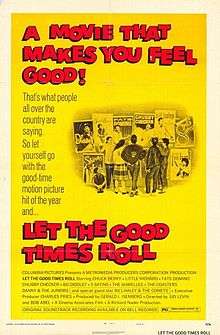Let the Good Times Roll (film)
| Let the Good Times Roll | |
|---|---|
 Theatrical release poster | |
| Directed by |
Robert Abel Sidney Levin |
| Produced by | Charles W. Fries |
| Cinematography | Robert C. Thomas |
| Edited by |
Bud Friedgen Hyman Kaufman |
| Distributed by | Columbia Pictures |
Release dates |
|
Running time | 99 minutes |
| Country | United States |
| Language | English |
| Box office | $1,050,000 (US/ Canada rentals)[1] |
Let the Good Times Roll is a 1973 rockumentary / concert film directed by Robert Abel and Sidney Levin. It features numerous stars from the American pop and rock music scene of the 1950s.
Summary
The film follows a concert in the 1970s, interspersed with footage of the singers from the 1950s. It also includes interviews with the singers.
Cast
The film features numerous stars from the 1950s and early 1960s playing as themselves, including[2]
- Chuck Berry
- Chubby Checker
- The Coasters
- Danny and the Juniors
- Bo Diddley
- Fats Domino
- The Five Satins
- Bill Haley and the Comets
- Little Richard
- The Shirelles
The film ends with a rare, and apparently impromptu, duet between Berry and Diddley, who had recorded together before, but were not often filmed on stage together.
Style
The film uses split screen techniques to contrast the performers' appearances in the 1950s and in the 1970s (as well as utilizing clips from 1950s-era films such as I Was a Teenage Werewolf). Vincent Canby, writing for The New York Times, described it as "avant-garde".[3]
Themes
Canby noted that the film seemed to have a possibly unintentional social commentary, with the majority-white audience giving the black fist to the majority-African American performers. He suggests that it implied that "there are no black memories of the nineteen-fifties".[3]
Christine Sprengler suggested that the film was an attempt to show "musical milestones" in the context of the times (both political and social), and, like American Graffiti and Grease, sets rock and roll as the soundtrack to the decade.[4]
Release and reception
Let the Good Times Roll received its premiere in New York, New York on 25 May 1973. It was later shown in Finland, Hungary, and Sweden.[5] Steven Otfinoski credits its success with bolstering Bo Diddley's career, which at the time was stagnating.[6]
Canby noted that the performers seemed much different than they were during their earlier careers, with gained weight, longer and thinner hair, and Little Richard having "openly embraced androgyny".[3] Overall, he considered the film an "engaging, technically superior concert film that recalls music of the nineteen-fifties".[3]
Mark Deming of Allmovie wrote that the artists are in "fine shape" and that Let the Good Times Roll is one of the "few movies about '50s rock that well and truly rocks".[7]
Soundtrack album
The Bell Records label released a 2-disc soundtrack album featuring performances from the film, including complete versions of songs truncated in the film (such as Bill Haley's "Shake, Rattle and Roll"). Omitted from the album, however, are any of Chuck Berry's performances due to Berry being under contract to Chess Records at the time.
References
- Footnotes
- ↑ "Big Rental Films of 1973", Variety, 9 January 1974 p 60
- ↑ IMDB, Let the Good Times.
- 1 2 3 4 Canby 1973, Screen: Music of the 50's.
- ↑ Sprengler 2009, pp. 44-45.
- ↑ IMDB, Release dates for Let.
- ↑ Otfinoski 2003, p. 59.
- ↑ Deming, Let the Good Times.
- Bibliography
- Canby, Vincent (26 May 1973). "Screen: Music of the 50's:'Let Good Times Roll' Is Rock Revival The Cast". The New York Times. Retrieved 1 October 2011.
- Demin, Mark. "Let the Good Times Roll (1973)". Allmovie. Rovi. Retrieved 1 October 2011.
- "Let the Good Times Roll (1973)". International Movie Database. Retrieved 1 October 2011.
- Otfinoski, Steven (2003). African Americans in the Performing Arts. New York: Facts on File. ISBN 978-0-8160-4807-6.
- "Release dates for Let the Good Times Roll (1973)". International Movie Database. Retrieved 1 October 2011.
- Sprengler, Christine (2009). Screening Nostalgia : Populuxe Props and Technicolor Aesthetics in Contemporary American Film. New York: Berghahn. ISBN 978-1-84545-559-0.